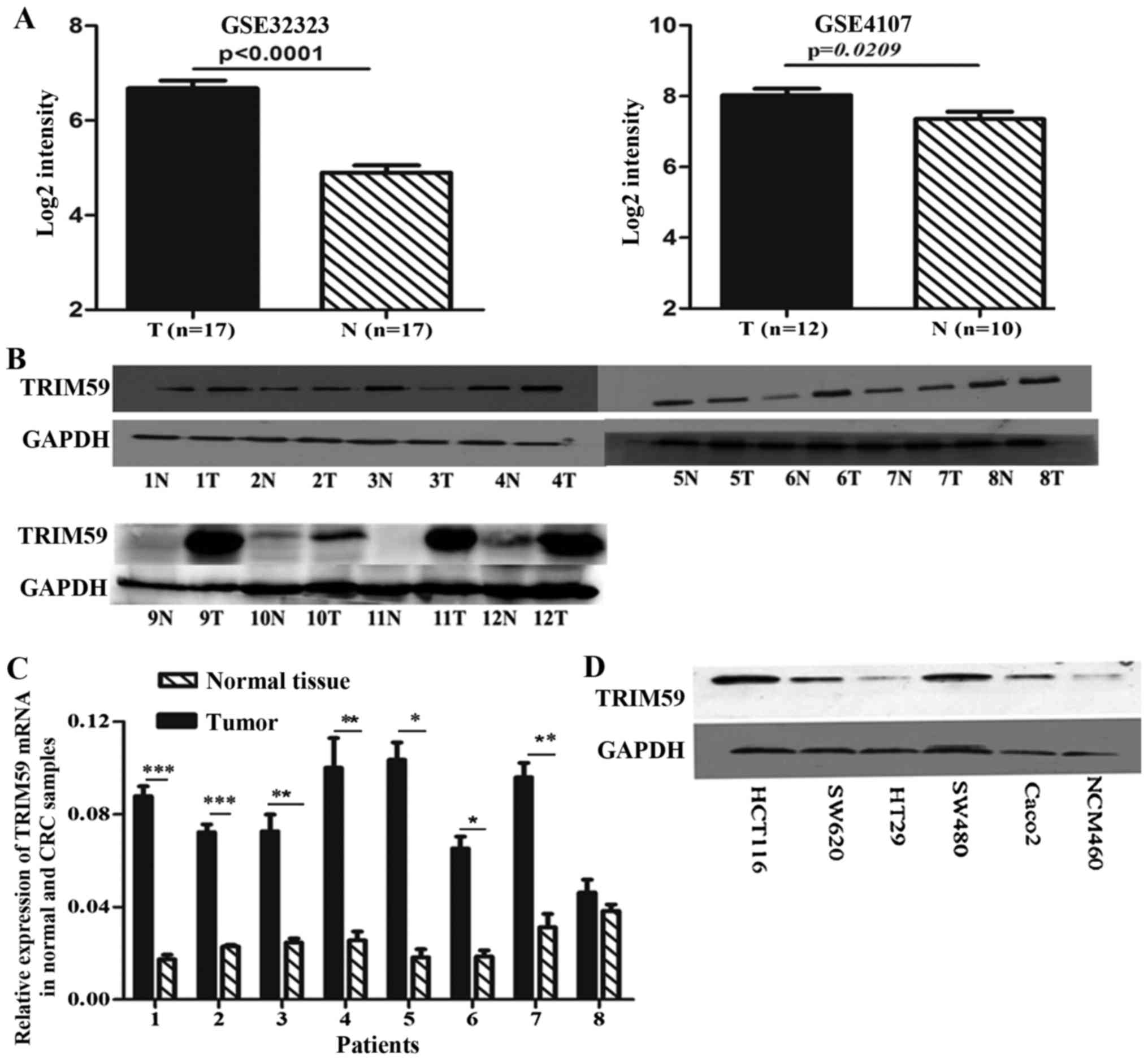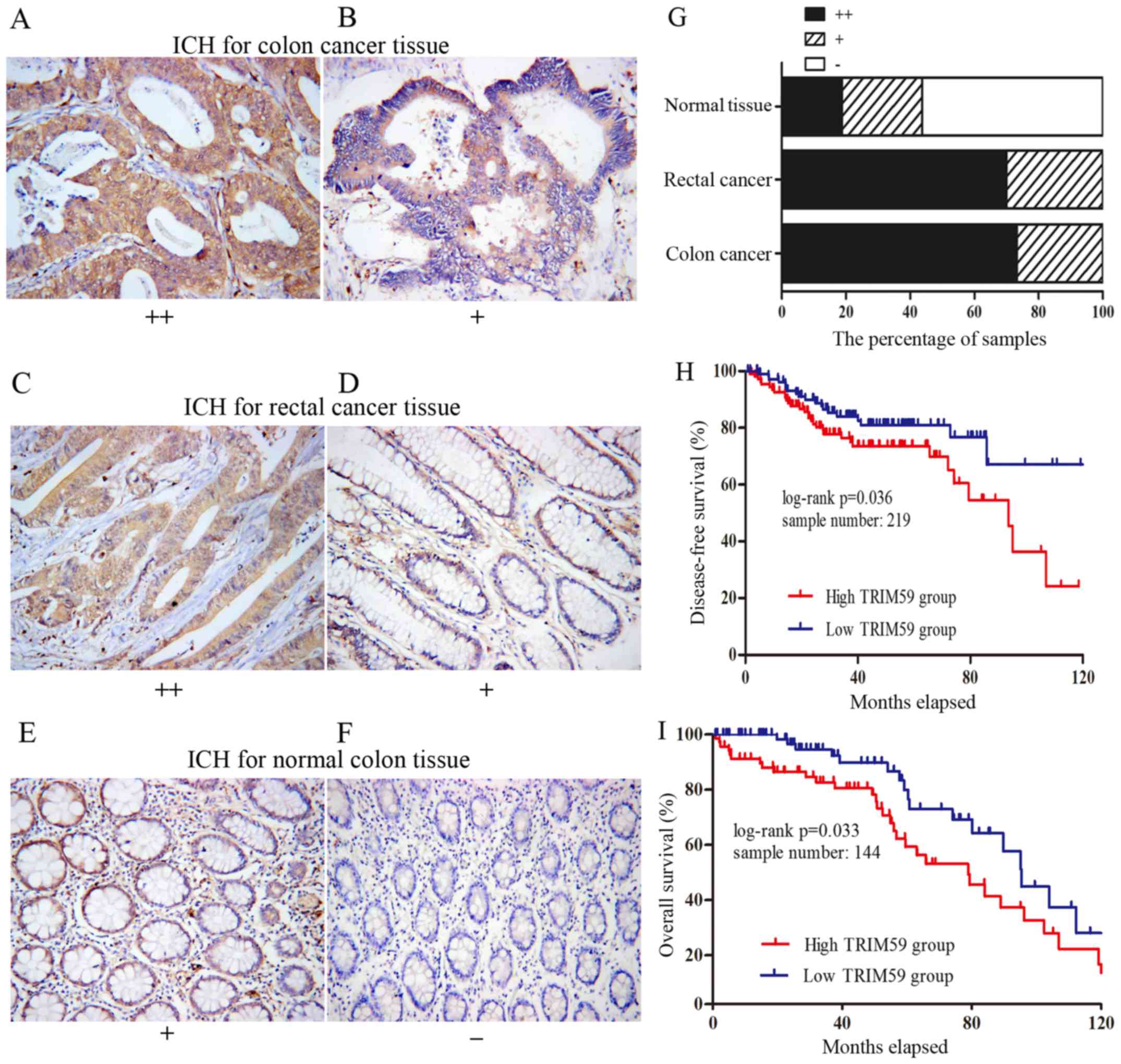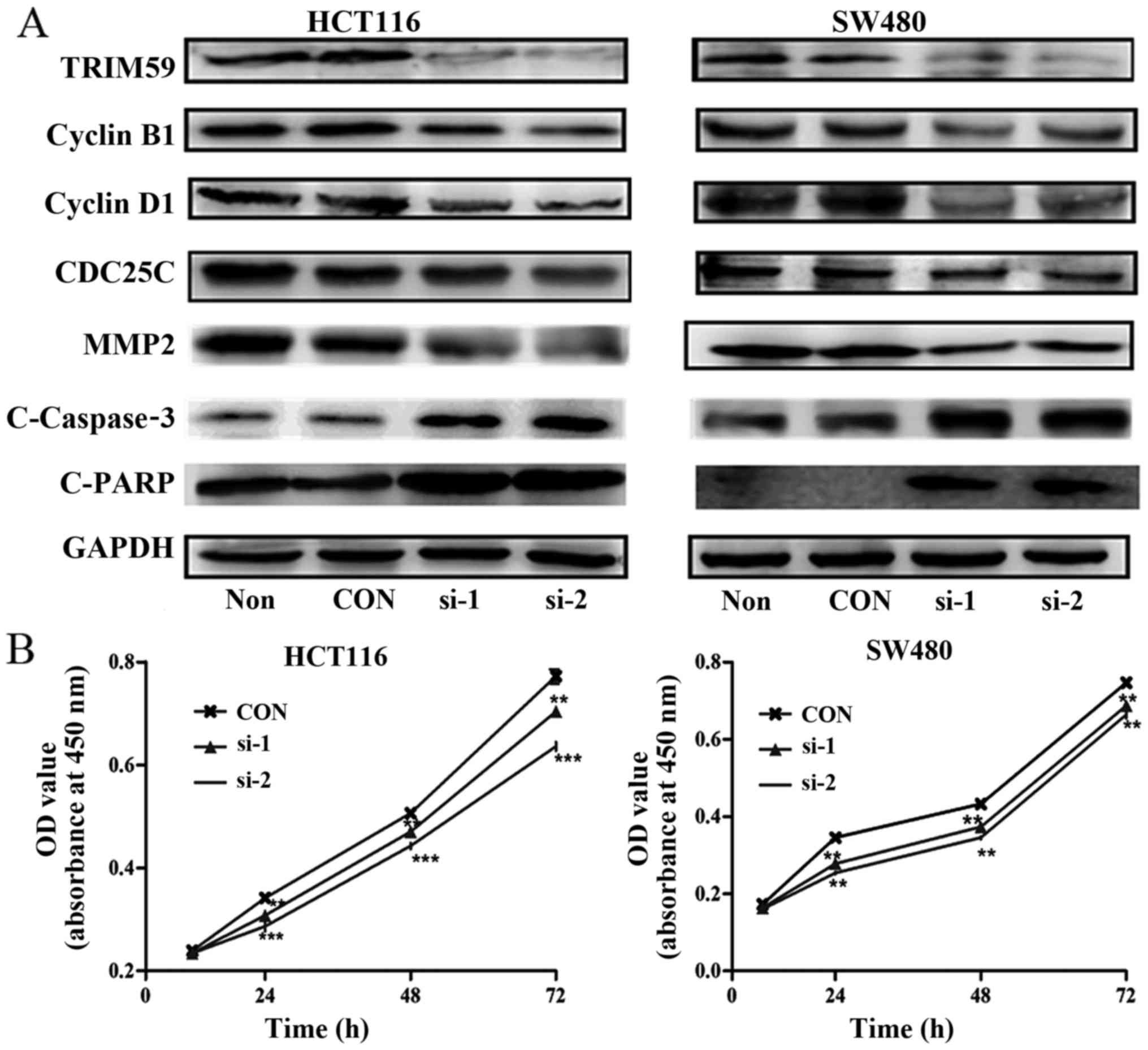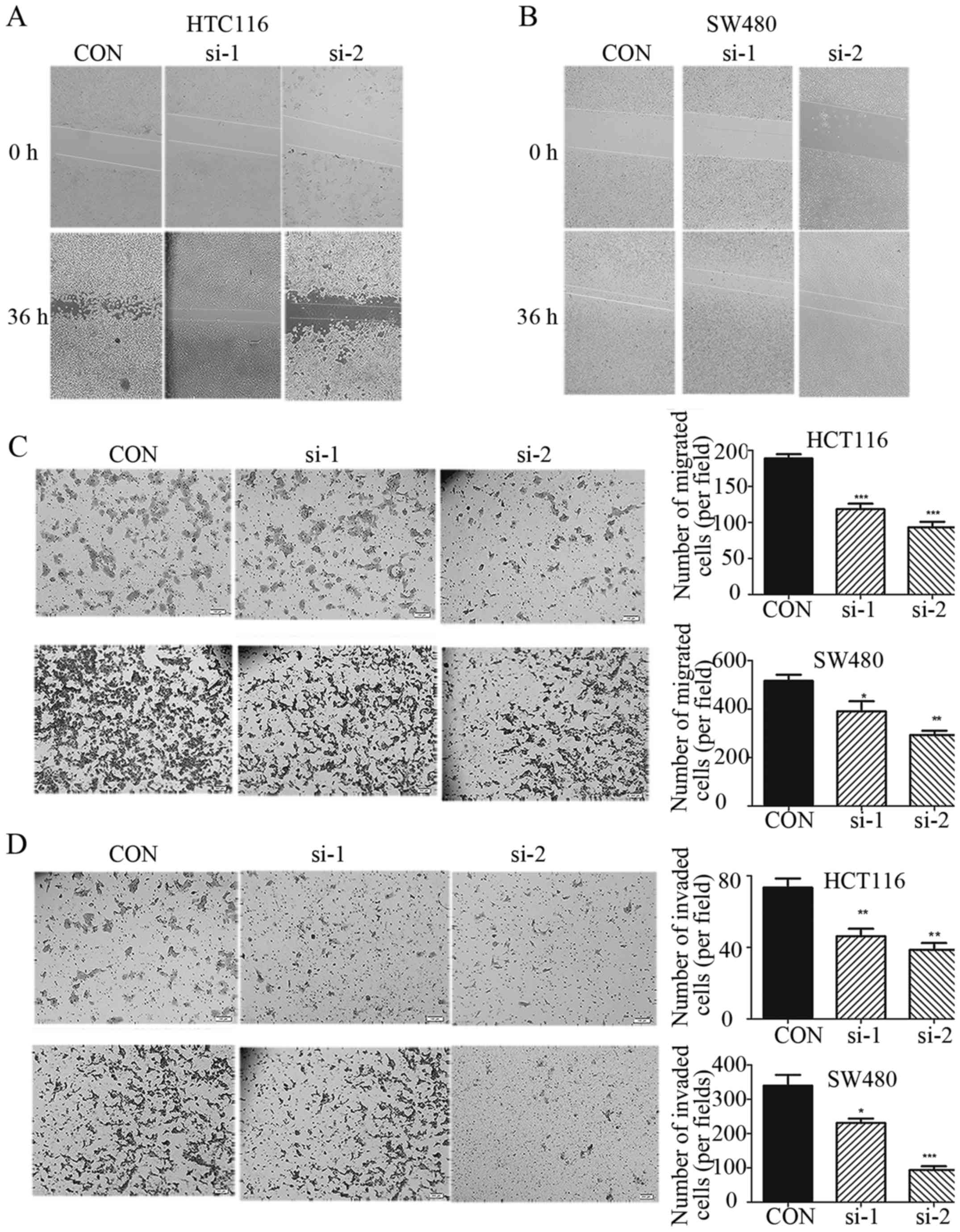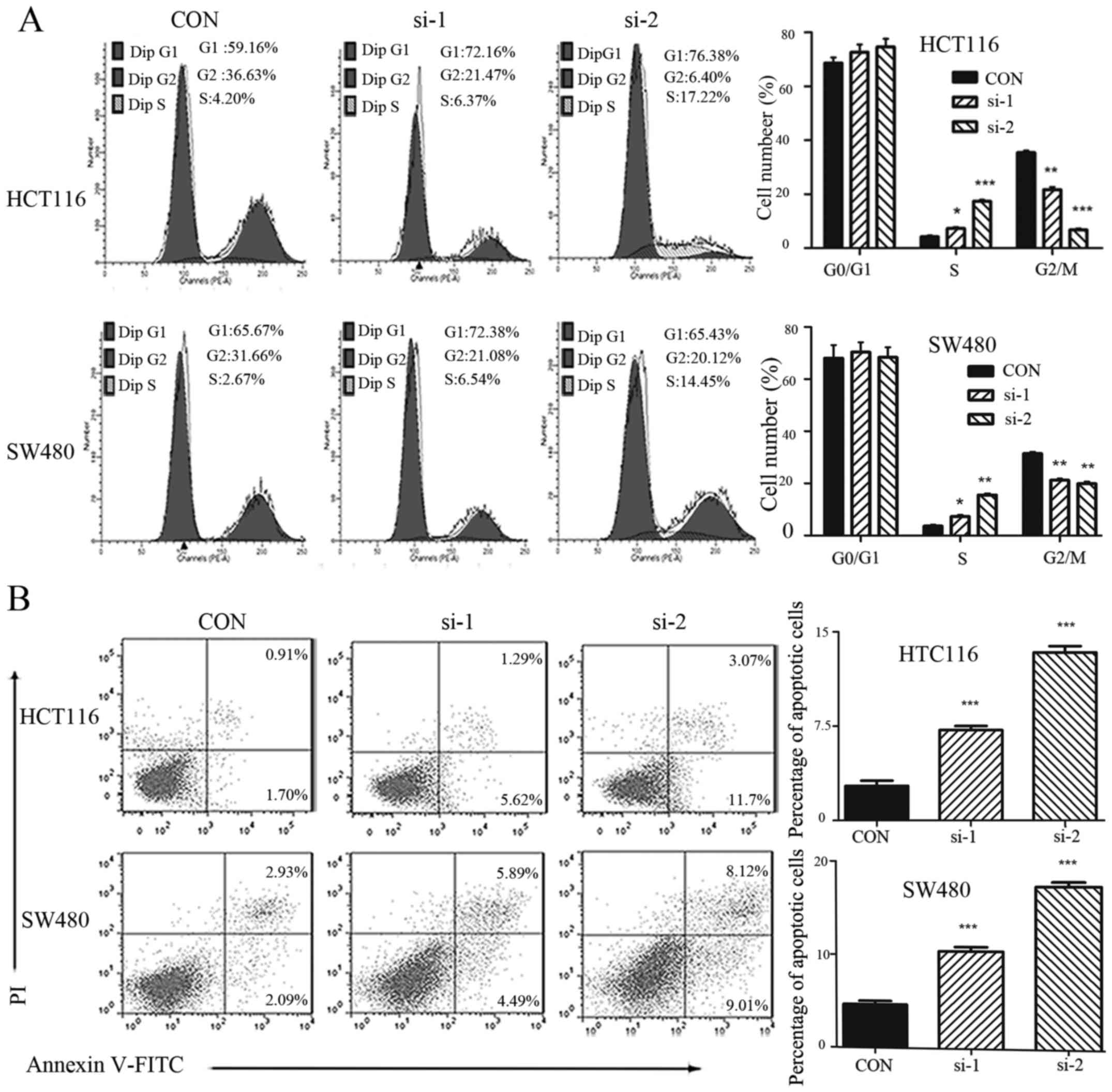Knockdown of tripartite motif-59 inhibits the malignant processes in human colorectal cancer cells
- Authors:
- Published online on: August 10, 2017 https://doi.org/10.3892/or.2017.5896
- Pages: 2480-2488
Abstract
Introduction
Colorectal cancer (CRC) is one of the most commonly diagnosed cancer and one of the leading causes of cancer mortality worldwide (1). Metastasis accounts for ~90% of patient deaths and is the most significant contributor to cancer death (2,3). CRC is often diagnosed in its advanced stage accompanied by metastasis, which is negatively correlated with patient survival (4). Since advanced metastatic CRC remains largely incurable, it is urgent to discover novel biomarkers which can influence its progression and contribute to diagnosis and treatment in early stage.
The tripartite motif (TRIM) proteins represent a large protein family comprising >70 members (5), constituted with a common N-terminal really interesting new gene (RING) finger domain, 1 or 2 B-box motifs and coiled-coil sequences, and most of them functioned as E3 ubiquitin ligases (6). According to previous studies, TRIM is implicated in many critical processes, such as viral infections, developmental and neurodegenerative disorders and cancer (5,7). In recent years, many scholars have found that TRIM proteins act as oncogenes or tumor suppressors in cancer growth. For example, TRIM13, TRIM19, TRIM24 and TRIM25 have been linked to leukemia, breast and prostate cancer (8), respectively. TRIM59, through the regulation of transcriptional factors or tumor suppressors, is strongly associated with gastric tumor (9), NSCLC (10) and renal cell cancer (11), but the function of the TRIM59 in CRC has not yet been reported.
In this study, we analyzed TRIM59 from independent Gene Expression Omnibus (GEO) datasets (www.ncbi.nlm.nih.gov/gds/) to determine the characteristic expression of TRIM59 in CRC. We found that TRIM59 is upregulated in CRC and significantly shortens patient survival through regulating cell proliferation, motility, cell cycle and inhibiting apoptosis of CRC cells.
Materials and methods
Patients and immunohistochemistry
Institutional Review Board (IRB)/Ethics Committee approval was obtained and the study was in adherence with the Declaration of Helsinki. The CRC samples and paired non-neoplastic tissues were obtained from Renmin Hospital of Wuhan University, and the study was approved by the local ethics committee. Before use, all cases were diagnosed by two pathologists without discrepancy. Formalin-fixed, paraffin-embedded CRC and non-neoplastic epithelial tissues were cut into 4 µm sections. The sections were deparaffinized in xylene and rehydrated in a series of ethanol of descending concentrations. For antigen unmasking, sections were immersed in antigen-unmasking solution and boiled in a microwave oven for 15 sec. Tissue sections were incubated with the TRIM59 primary antibody at room temperature for 60 min, followed by the standard procedure for the S-P immunohistochemical kit (Fujian Maixin Biological Technology, Co., Ltd., Fuzhou, China). Expression level of TRIM59 was ascertained according to the evaluations of the pathologists. The data of mRNA expression profile GSE14333 (12), GSE17536 (13), GSE4107 (14) and GSE32323 (15) were downloaded from the GEO database.
Cell culture, small interfering RNA and antibodies
HCT116, SW480, SW620, HT29, Caco2 and NCM460 cells were maintained in PRMI-1640 medium (Invitrogen) supplemented with 10% fetal bovine serum (FBS), 100 U/ml penicillin and 100 mg/ml streptomycin. Cells were cultured at 37°C in 5% CO2. Two different small interfering RNA (siRNA) oligo duplexes were produced by Invitrogen (Carlsbad, CA, USA). The target sequences for the TRIM59 gene were: siRNA-1: GCCUCUCUAUCUGUUUACCAAAGUU; siRNA-2: UCC UCGUGUACUGCCAUGCUCUCAU; The negative control from Invitrogen was used as a control. The specific siRNA or negative control was transfected into CRC cells with Lipofectamine 2000 transfection reagent (Invitrogen) according to the manufacturers instructions. Primary antibody TRIM59 was purchased from Abcam (ab69639) and anti-caspase-3 (25546–1-AP), PARP (13371–1-AP), cyclin B1 (55004–1-AP), cyclin D1 (0186–1-Ig), CDC25C (16485–1-AP), MMP2 (10373–2-AP) were purchased from Proteintech (Rosemont, IL, USA).
Western blot analysis
CRC proteins were separated by SDS-PAGE. Proteins were electro-blotted onto a polyvinylidene fluoride membrane and were blocked for 30 min in TBST [0.05% Tween-20 in phosphate buffered saline (PBS)] with 5% dried skimmed milk at room temperature. Immunoblot analysis was performed using primary antibodies overnight at 4°C. Membranes were then washed with TBST and incubated with horseradish peroxidase (HRP)-labeled secondary antibody in TBST for 45 min and then visualized using a chemiluminescent ECL detection kit (Santa Cruz Biotechnology, Santa Cruz, CA, USA). GAPDH was used as a control for protein loading.
RNA isolation and real-time PCR analysis
Total RNA was isolated from cell lines or tissues with TRIzol reagents (Invitrogen) according to the manufacturers instructions. Quatitative real-time PCR (qRT-PCR) was performed to quantify mRNA expression with SYBR® Green PCR Master Mix (Takara Bio, Shiga, Japan). GAPDH was used for TRIM59 normalization. Primers were as follow: TRIM59: forward, 5-TACGAGAGCAGCAGCTTGAA-3 and reverse, 5-ACGG GTTGAACCTCAGGAAG-3; GAPDH: forward, 5-GTGGA CATCCGCAAAGAC-3 and reverse, 5-AAAGGGTGTAAC GCAACTA-3.
Cell proliferation assay
Cells were plated in 96-well plates and examined at 12, 24, 48 and 72 h after plating (n=6). Cells were incubated with the Cell Counting kit-8 (CCK-8; Dojindo Laboratories, Kumamoto, Japan) for 1 h. Then the absorbance was measured with the multifunctional microplate reader at 450 nm.
Cell cycle analysis
Cells were harvested and resuspended twice with PBS. After centrifugation, cells were fixed in 70% ice-cold methanol for at least 2 h at −20°C. Then the fixed cells were stained with propidium iodide (PI) (50 µl/ml PI and 250 µl/ml RNase A) for 30 min. In each experiment, 2×105 cells were analyzed using BD FACSAria (BD Biosciences, San Jose, CA, USA). Experiments were performed in triplicate. ModFit 2.0 software was used to determine the percentage of cells in G0/G1, S and G2/M phases.
Apoptosis analysis
Annexin V-FITC/PI staining was performed to investigate whether TRIM59 regulates the apoptosis of CRC cells. The cells of each group were stained with Annexin V-FITC/PI apoptosis detection kit (Invitrogen), according to the manufacturer's instructions. Experiments were performed in triplicate. FlowJo 7.6.1 software was used to determine the percentage of apoptotic cells.
In vitro migration and invasion assays
In the scratch wound healing assay, cells were cultured in serum-free medium for 24 h and wounded with pipette tips. Then the medium was refreshed. The wound closing procedure was observed 36 h later and images were taken. In vitro tumor cell migration was measured using Transwell chambers (Corning, Inc., Corning, NY, USA) according to the manufacturers instruction. In brief, 2×105 cells with/without siRNA in 2% FBS RPMI-1640 medium were plated in the upper chamber and incubated with RPMI-1640 medium containing 10% FBS in the bottom chamber for 48 h. Subsequently, the number of cells on the bottom surface, which migrated across the membranes, were counted after staining by 0.1% crystal violet dye. Cell counting was carried out in five separate areas under a microscope. The invasion assay was the same except that Matrigel basement was contained in the BD BioCoat Matrigel Transwell Chambers (BD Biosciences, Bedford, MA, USA). The data are presented as mean ± standard deviation (SD).
Statistical analysis
Survival analyses were carried out using the Kaplan-Meier method and the results were statistically analysed by the log-rank test. The correlations between the gene expression and the clinicopathological features were analyzed by the Chi-square test. A significant difference was defined as P<0.05. Statistical analyses were performed using the GraphPad Prism (v.6.0).
Results
TRIM59 is upregulated in CRC on both mRNA and protein levels
To determine the significance of TRIM59 in CRC, we first analyzed the expression of TRIM59 at the mRNA level in the cohorts of CRC patients available from two independent GEO datasets GSE4107 and GSE32323. The two datasets involve paired CRC tumors and adjacent non-cancerous tissue mRNA information. We chose all the data of TRIM59 mRNA for statistical analyses. As shown in Fig. 1A, TRIM59 mRNA levels increased significantly in human colorectal tumor samples as compared with the adjacent normal colorectal tissues.
To verify the microarray analysis results, we performed immunoblot and qRT-PCR experiments on human colorectal adenocarcinoma specimens and their matched normal tissues. Seven of 12 tumor samples showed increased protein level of TRIM59 compared with their respective paired normal tissues (Fig. 1B). In addition, qRT-PCR experiments found significantly higher TRIM59 mRNA expression in the tumor tissues (Fig. 1C). Expression of TRIM59 was determined by western blot analysis in several CRC cell lines, including HCT116, SW480, SW620, HT29, Caco2 and the normal colon cell line NCM460. According to the tissue results, significantly higher expression of TRIM59 was detected in most CRC cells, compared to NCM460 cells (Fig. 1D). To further investigate the correlation of TRIM59 with CRC progression, we also examined the expression levels of TRIM59 in 80 human CRC tissues (60 cases of colon cancer and 20 cases of rectal carcinoma) and 16 normal colon tissues by immunohistochemical staining. TRIM59 was found mainly in the cytoplasm (Fig. 2A-E), which was consistent with previous reports (9,16). The percentage of strongly positive samples in cancer tissues (72.5%, 58/80) was significantly higher than that in normal colon tissues (18.75%, 3/16) (P<0.0001, Yates corrected χ2 analysis). Of the 60 colon cancer samples, 44 (73.3%) were strongly positive and 16 (26.7%) were weakly positive (Fig. 2A and B). Whereas, 14 (70%) of the rectal cancer samples were strongly positive and only 6 (30%) were weakly positive (Fig. 2C and D). In contrast, of the 16 normal tissue samples, 9 (56.25%) were negative, 4 (25%) were weakly positive and only 3 (27.9%) were strongly positive (Fig. 2E and F). Distributions of TRIM59 staining grades are shown in Fig. 2G. Our results implied that TRIM59 expression was upregulated at the protein level in CRC.
These data evidently demonstrated that TRIM59 was upregulated in CRC in both mRNA and protein levels, implying its importance in CRC pathogenesis.
The expression level of TRIM59 is correlated with disease progression as well as shortened patient survival
In order to confirm the correlations between the TRIM59 expression level and the clinicopathological factors in CRC, we downloaded clinical information for GSE14333 and analyzed it statistically. The samples pooled in the dataset were then classified into two groups according to the TRIM59 expression level in tumor tissue and the χ2 test was applied. As shown (Table I), higher TRIM59 expression was closely associated with Dukes stage (P=0.004). The results indicated that high expression of TRIM59 is related to rapid carcinoma spread. Moreover, we downloaded clinical information and performed Kaplan-Meier survival analysis. The two datasets (GSE17536 and GSE14333) contain mRNA information of CRC and disease-free survival (DFS) or overall survival (OS). We chose all the samples that contained complete TRIM59 mRNA and survival information for analysis. The results showed that CRC patients with tumors displaying high TRIM59 expression level had significantly shorter OS and DFS compared to those with tumors with low TRIM59 expression (Fig. 2H and I) (P=0.033 and P=0.036, respectively). The results strongly suggested that TRIM59 may act as an oncogene in CRC and could represent a new potential prognostic factor for CRC after curative colorectal resection.
Table I.Correlations between the TRIM59 expression and the clinicopathological features of colorectal carcinoma (GSE14333). |
TRIM59 modulates CRC cell proliferation
To validate the biological role of TRIM59 in the proliferation of CRC cells, TRIM59 was depleted using three siRNAs in HCT116 and SW480 cells, which exhibit a higher expression of TRIM59. After transfecting the three siRNAs into CRC cells, the protein level of TRIM59 was affirmed by western blot analysis. As shown in the Fig. 3A, both siRNA-1 and siRNA-2 efficiently knocked down TRIM59 in the two cell lines compared with that of control siRNA. Next, we examined the effects of siRNA-induced knockdown of TRIM59 on the growth of CRC cell lines. As shown in Fig. 3B, HCT116 and SW480 cells displayed a lower cell proliferation rate than control cells, there was statistical significant difference (P<0.05). These data suggested that TRIM59 is closely associated with the proliferation of CRC cells.
TRIM59 modulates cell migration and invasion of CRC cells
The role of TRIM59 in modulating CRC cell proliferation is in agreement with previous reports in cervical (17) and prostate cancer (16). In addition to cell proliferation, the role of TRIM59 in cancer metastasis has not been well characterized. We examined whether TRIM59 have an impact on cell migration and invasion. As shown in Fig. 4A and B, we performed a wound healing assay. The ‘wound’ was almost healed after 36 h in control cells. However, the healing of the open area was markedly attenuated when TRIM59 was knocked down. In order to further prove this effect, we also performed a Transwell assay. Importantly, knockdown of TRIM59 suppressed the migration and invasion rates of HCT116 and SW480 cells (Fig. 4C and D). It is well known that MMPs, especially MMP-2, is significantly involved in the invasion and metastasis of human tumors (18). When TRIM59 is knocked down in HCT116 and SW480 cells, MMP2 is downregulated (Fig. 3A). TRIM59 modulates CRC cell migration and invasion. This may be by regulating the expression of MMP-2. These observations suggest that knockdown of TRIM59 significantly inhibits cell migration and invasion abilities in HCT116 and SW480 cells and upregulation of TRIM59 may have important consequences on the metastasis of CRC.
Knockdown of TRIM59 arrests cell cycle in S phase
Cell proliferation depends largely on cell cycle progression. Hence, the effect of TRIM59 knockdown on cell cycle progression was also assessed using flow cytometry. After treatment with si-TRIM59 or control siRNA for 48 h, cells were collected and stained by PI. TRIM59 knockdown led to a significant accumulation of cells at the S-phase with cell proportion in G2/M phase largely decrease in HCT116 and SW480 cells (Fig. 5A). These data suggest that knockdown of TRIM59 interrupts cell cycle progression leading to the accumulation of cells in S phase. We proceeded to detect the expression levels of cyclins, which are key cell cycle regulators (19). As shown in Fig. 3A, the cyclin family proteins cyclin D1, CDC25C and cyclin B1 were downregulated following TRIM59 knockdown, while the level of the internal control GAPDH remained stable. The regulation of cyclins by TRIM59 might underlie the TRIM59-mediated cell cycle arrest in CRC cells.
Downregulation of TRIM59 causes apoptosis in CRC cells
Inhibiting apoptosis is crucial for sustaining proliferation. To further explore how TRIM59 regulates the proliferation of CRC cells, we investigated the contribution of apoptosis to growth inhibition in SW480 and HCT116 cells with or without TRIM59 knockdown. As expected, the apoptotic indexes of TRIM59-silenced cells and control cells were 7.19% (si-1), 13.37% (si-2) and 2.76% (control), (HCT116, P<0.05), 10.39% (si-1), 17.25% (si-2) and 4.66% (control) (SW480, P<0.05) (Fig. 5B), suggesting that silencing TRIM59 significantly promoted cell apoptosis.
Cell apoptosis is closely related to the regulation of apoptosis-related genes including Bcl-2 and caspase gene families (20). We measured apoptotic markers and the cleavage of caspase-3 and PARP (indicating a pro-apoptotic phenotype). These were higher when TRIM59 was depleted (Fig. 3A).
These results revealed that TRIM59 may exert an inhibitory effect on the caspase-dependent apoptosis pathway.
Discussion
The present study indicates that TRIM59 promotes CRC progression, which is similar to previous studies in other cancer types such as NSCLC (10), gastric cancer (9,21), renal cell carcinoma (11) and osteosarcoma (22). Significantly shortened survival is seen in patients with high TRIM59 expression compared with those with low TRIM59 expression. Our data showed knockdown of TRIM59 inhibited the cell cycle and promoted apoptosis in CRC cells in vitro, which may result in slower cancer cell proliferation. However, the underlying mechanism still remains unclear, and here several possible explanations are proposed.
Firstly, a hallmark of cancer cells is sustaining proliferative signaling, this can be achieved by inactivation of tumor suppressor genes. p53, a widely known tumor suppressor (23). At present, whether p53 is regulated by TRIM59 remain controversial. Some authors hold that p53 is negatively regulated by TRIM59 via ubiquinitation, by which TRIM59 promotes tumor growth, cell proliferation and migration (9). Hence, the SV40 Tag/p53/pRB routes can be considered one mechanism for TRIM59 functioning in the process of tumorigenesis. However, others believed that TRIM59 may promote cancer cell growth through other pathways but not the p53 signaling pathway (10). In this study, HCT116 is a p53 wild-type; in contrast, SW480 is mutant p53 cell line. When knocking down TRIM59, the two different cells have similar response, inferring that possibly TRIM59 is not mediated through p53, so further research is needed. In addition, the TRIM family is an evolutionarily conserved gene family implicated in a number of critical processes including transcriptional regulation (24,25). The domain of the really interesting new gene (RING) is frequently involved in proteolysis, acting as E3 ubiquitin ligase and the ubiquitin-proteasome system in the regulation of numerous cellular processes including cell cycle regulatory proteins, transcription factors and signal transducers (26). Valiyeva et al (27) recently identified TRIM59 as an early signal transducer in two (SV40Tag and Ras) oncogene pathways in murine prostate cancer models. High expression level of TRIM59 may activate the transcription of some crucial downstream oncogenes, which, in turn promotes the progression of cancers. Furthermore, it is reported that TRIM59 is involved in NF-κB and IRF3/IRF7 mediated signaling pathways (28), both of which are dysregulated in nearly all tumors and considered to be driver genes of cancer. We hypothesize that high expression of TRIM59 will regulate NF-κB and IRF3/IRF7 pathways in CRC, which remains to be validated. Lastly, c-Myc overexpression and DNA promoter hypermethylation repress the expression of TRIM59 in cancers (29). These reports suggest several possible mechanisms by which TRIM59 may regulate cell cycle progression in colorectal cancer.
In the present study, we demonstrated that TRIM59 modulates not only proliferation, but also motility, migration and invasion. In CRC, metastasis accounts for ~90% of patient deaths, representing the most lethal event during the course of the disease (30). Metastasis is directly linked to patient survival, and critically limits successful therapy (31,32). Metastasis formation is a major hurdle in CRC therapy. Therefore, to identify patients at high risk for metastasis formation, early diagnosis and molecular characterization of the primary tumor is crucial to define prognostic and therapeutic targets (33). Our results indicated that TRIM59 is an important target for blocking metastasis in CRC. We propose that quantification of TRIM59 in colon biopsies could be used in combination with pathologic examination to predict biological behavior of the CRC. The molecular pathologic diagnosis will be helpful in personalized treatment optimization.
In summary, the present study has shown the biological and clinical significance of TRIM59 in CRC. This study demonstrated that TRIM59 expression is significantly upregulated in CRC tissues and associated with tumor Dukes stage. Knockdown of TRIM59 with specific siRNA inhibited cancer cell proliferation and led to cell cycle arrest in the S-phase. Regulation of cell cycle progression and promotion of apoptosis may underlie TRIM59-mediated CRC development. Our evidence provides novel clues that may aid CRC diagnosis and treatment in the future. However, further in depth exploration of the molecular mechanisms of TRIM59 in promoting proliferation and metastasis will be needed.
Acknowledgements
The authors would like to thank the anonymous reviewers for their helpful comments. The authors also would like to thank Dr Katelyn ONeill from the University of Nebraska Medical Center for improving the language of this manuscript.
References
|
Terzic J, Grivennikov S, Karin E and Karin M: Inflammation and colon cancer. Gastroenterology. 138:2101–2114.e5. 2010. View Article : Google Scholar : PubMed/NCBI | |
|
Stein U and Schlag PM: Clinical, biological, and molecular aspects of metastasis in colorectal cancer. Recent Results Cancer Res. 176:61–80. 2007. View Article : Google Scholar : PubMed/NCBI | |
|
Li W, Cai S, Wang L, Yang C, Zhou B and Wang H: HINT2 downregulation promotes colorectal carcinoma migration and metastasis. Oncotarget. 8:13521–13531. 2017.PubMed/NCBI | |
|
Mathot L, Kundu S, Ljungström V, Svedlund J, Moens L, Adlerteg T, Falk-Sörqvist E, Rendo V, Bellomo C, Mayrhofer M, et al: Somatic ephrin receptor mutations are associated with metastasis in primary colorectal cancer. Cancer Res. 77:1730–1740. 2017. View Article : Google Scholar : PubMed/NCBI | |
|
Elabd S, Meroni G and Blattner C: TRIMming p53s anticancer activity. Oncogene. 35:5577–5584. 2016. View Article : Google Scholar : PubMed/NCBI | |
|
Ozato K, Shin DM, Chang TH and Morse HC III: TRIM family proteins and their emerging roles in innate immunity. Nat Rev Immunol. 8:849–860. 2008. View Article : Google Scholar : PubMed/NCBI | |
|
Tomar D and Singh R: TRIM family proteins: Emerging class of RING E3 ligases as regulator of NF-κB pathway. Biol Cell. 107:22–40. 2015. View Article : Google Scholar : PubMed/NCBI | |
|
Hatakeyama S: TRIM proteins and cancer. Nat Rev Cancer. 11:792–804. 2011. View Article : Google Scholar : PubMed/NCBI | |
|
Zhou Z, Ji Z, Wang Y, Li J, Cao H, Zhu HH and Gao WQ: TRIM59 is up-regulated in gastric tumors, promoting ubiquitination and degradation of p53. Gastroenterology. 147:1043–1054. 2014. View Article : Google Scholar : PubMed/NCBI | |
|
Zhan W, Han T, Zhang C, Xie C, Gan M, Deng K, Fu M and Wang JB: TRIM59 promotes the proliferation and migration of non-small cell lung cancer cells by upregulating cell cycle related proteins. PLoS One. 10:e01425962015. View Article : Google Scholar : PubMed/NCBI | |
|
Khatamianfar V, Valiyeva F, Rennie PS, Lu WY, Yang BB, Bauman GS, Moussa M and Xuan JW: TRIM59, a novel multiple cancer biomarker for immunohistochemical detection of tumorigenesis. BMJ Open. 2:e0014102012. View Article : Google Scholar : PubMed/NCBI | |
|
Jorissen RN, Gibbs P, Christie M, Prakash S, Lipton L, Desai J, Kerr D, Aaltonen LA, Arango D, Kruhøffer M, et al: Metastasis-associated gene expression changes predict poor outcomes in patients with Dukes stage B and C colorectal cancer. Clin Cancer Res. 15:7642–7651. 2009. View Article : Google Scholar : PubMed/NCBI | |
|
Freeman TJ, Smith JJ, Chen X, Washington MK, Roland JT, Means AL, Eschrich SA, Yeatman TJ, Deane NG and Beauchamp RD: Smad4-mediated signaling inhibits intestinal neoplasia by inhibiting expression of β-catenin. Gastroenterology. 142:562–571.e2. 2012. View Article : Google Scholar : PubMed/NCBI | |
|
Hong Y, Ho KS, Eu KW and Cheah PY: A susceptibility gene set for early onset colorectal cancer that integrates diverse signaling pathways: Implication for tumorigenesis. Clin Cancer Res. 13:1107–1114. 2007. View Article : Google Scholar : PubMed/NCBI | |
|
Khamas A, Ishikawa T, Shimokawa K, Mogushi K, Iida S, Ishiguro M, Mizushima H, Tanaka H, Uetake H and Sugihara K: Screening for epigenetically masked genes in colorectal cancer Using 5-Aza-2-deoxycytidine, microarray and gene expression profile. Cancer Genomics Proteomics. 9:67–75. 2012.PubMed/NCBI | |
|
Lin WY, Wang H, Song X, Zhang SX, Zhou PS, Sun JM and Li JS: Knockdown of tripartite motif 59 (TRIM59) inhibits tumor growth in prostate cancer. Eur Rev Med Pharmacol Sci. 20:4864–4873. 2016.PubMed/NCBI | |
|
Aierken G, Seyiti A, Alifu M and Kuerban G: Knockdown of tripartrtite-59 (TRIM59) inhibits cellular proliferation and migration in human cervical cancer cells. Oncol Res. 25:381–388. 2016. View Article : Google Scholar : PubMed/NCBI | |
|
Xing P, Liao Z, Ren Z, Zhao J, Song F, Wang G, Chen K and Yang J: Roles of low-density lipoprotein receptor-related protein 1 in tumors. Chin J Cancer. 35:62016. View Article : Google Scholar : PubMed/NCBI | |
|
Koosha S, Alshawsh MA, Looi CY, Seyedan A and Mohamed Z: An association map on the effect of flavonoids on the signaling pathways in colorectal cancer. Int J Med Sci. 13:374–385. 2016. View Article : Google Scholar : PubMed/NCBI | |
|
Shu YJ, Weng H, Ye YY, Hu YP, Bao RF, Cao Y, Wang XA, Zhang F, Xiang SS, Li HF, et al: SPOCK1 as a potential cancer prognostic marker promotes the proliferation and metastasis of gallbladder cancer cells by activating the PI3K/AKT pathway. Mol Cancer. 14:122015. View Article : Google Scholar : PubMed/NCBI | |
|
Luo D, Wang Y, Huan X, Huang C, Yang C, Fan H, Xu Z and Yang L: Identification of a synonymous variant in TRIM59 gene for gastric cancer risk in a Chinese population. Oncotarget. 8:11507–11516. 2016. | |
|
Liang J, Xing D, Li Z, Shen J, Zhao H and Li S: TRIM59 is upregulated and promotes cell proliferation and migration in human osteosarcoma. Mol Med Rep. 13:5200–5206. 2016. View Article : Google Scholar : PubMed/NCBI | |
|
Charni M, Aloni-Grinstein R, Molchadsky A and Rotter V: p53 on the crossroad between regeneration and cancer. Cell Death Differ. 24:8–14. 2017. View Article : Google Scholar : PubMed/NCBI | |
|
Gack MU, Shin YC, Joo CH, Urano T, Liang C, Sun L, Takeuchi O, Akira S, Chen Z, Inoue S, et al: TRIM25 RING-finger E3 ubiquitin ligase is essential for RIG-I-mediated antiviral activity. Nature. 446:916–920. 2007. View Article : Google Scholar : PubMed/NCBI | |
|
Lerner M, Corcoran M, Cepeda D, Nielsen ML, Zubarev R, Pontén F, Uhlén M, Hober S, Grandér D and Sangfelt O: The RBCC gene RFP2 (Leu5) encodes a novel transmembrane E3 ubiquitin ligase involved in ERAD. Mol Biol Cell. 18:1670–1682. 2007. View Article : Google Scholar : PubMed/NCBI | |
|
Deshaies RJ and Joazeiro CA: RING domain E3 ubiquitin ligases. Annu Rev Biochem. 78:399–434. 2009. View Article : Google Scholar : PubMed/NCBI | |
|
Valiyeva F, Jiang F, Elmaadawi A, Moussa M, Yee SP, Raptis L, Izawa JI, Yang BB, Greenberg NM, Wang F, et al: Characterization of the oncogenic activity of the novel TRIM59 gene in mouse cancer models. Mol Cancer Ther. 10:1229–1240. 2011. View Article : Google Scholar : PubMed/NCBI | |
|
Kondo T, Watanabe M and Hatakeyama S: TRIM59 interacts with ECSIT and negatively regulates NF-κB and IRF-3/7-mediated signal pathways. Biochem Biophys Res Commun. 422:501–507. 2012. View Article : Google Scholar : PubMed/NCBI | |
|
Licchesi JD, Van Neste L, Tiwari VK, Cope L, Lin X, Baylin SB and Herman JG: Transcriptional regulation of Wnt inhibitory factor-1 by Miz-1/c-Myc. Oncogene. 29:5923–5934. 2010. View Article : Google Scholar : PubMed/NCBI | |
|
Dahlmann M, Kobelt D, Walther W, Mudduluru G and Stein U: S100A4 in cancer metastasis: Wnt signaling-driven interventions for metastasis restriction. Cancers (Basel). 8:E592016. View Article : Google Scholar : PubMed/NCBI | |
|
Fodde R, Smits R and Clevers H: APC, signal transduction and genetic instability in colorectal cancer. Nat Rev Cancer. 1:55–67. 2001. View Article : Google Scholar : PubMed/NCBI | |
|
Stein U and Schlag PM: Clinical, biological, and molecular aspects of metastasis in colorectal cancer. Recent Results Cancer Res. 176:61–80. 2007. View Article : Google Scholar : PubMed/NCBI | |
|
Dahlmann M, Okhrimenko A, Marcinkowski P, Osterland M, Herrmann P, Smith J, Heizmann CW, Schlag PM and Stein U: RAGE mediates S100A4-induced cell motility via MAPK/ERK and hypoxia signaling and is a prognostic biomarker for human colorectal cancer metastasis. Oncotarget. 5:3220–3233. 2014. View Article : Google Scholar : PubMed/NCBI |



